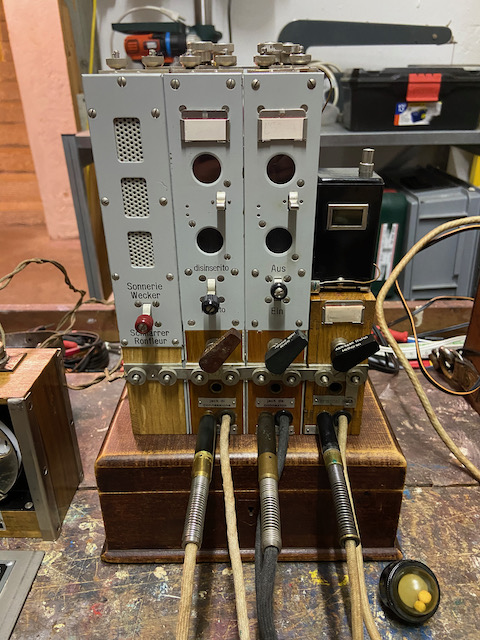
Each switchboard unit contains the elements of one single cord switchboard line and connection latches which allow to unify several units to a small switchboard. Any field telephone can then be connected to these unification latches to serve as operator telephone.
This small switchboard units were first used by the german army in WWI. The Swiss Army acquired initially the German model from 1915 (Swiss army Modell 18) and then introduced improved versions developed in 1932 and 1938 (VK 32, VK 38). Here we will describe in more detail the versions 18 and 38.
The Swiss Army Vermittlungskästchen Modell 18 was introduced in 1920. It is the exact same as the German WWI Vermittlungskästchen and was developed and made by Siemens & Halske. The first batch of 1000 units was imported in 1919. An additional ~2000 units were acquired during the 20ies. According to literature all were made by Siemens & Halske in Germany. My specimen shows a small Telephonwerke Albisrieden stamp on the relay flap indicator module, perhaps later (after 1924) devices or at least later relay flap modules were made in Switzerland. Telephonwerke Albisrieden was the Swiss Siemens & Halske subsidiary operating under that name from 1924 to 1935.
Description from "Vorschriften für den Telefon- und optischen Signaldienst der Artillerie, 1941" (Translated and slightly abridged):
The V.K. is used to build small telephone exchanges for buzzer or magneto call. With regard to the functioning and operation of the V.K. the following applies:
- a. The La wire is connected to the La terminal. Connect the earth wire to terminal Lb/E for single-wire lines or the Lb wire for double-wire lines.
- b. The attachable buzzer indicator is a small phone. On its membrane lie two elderberry beads under a celluloid cover. On an incoming buzzer call the membrane is set in vibration so that the elderberry beads move. At the same time there is a buzzing sound.
- c. The relay flap can be inserted instead of the buzzer indicator. It only responds when called with magneto. In this case a yellow indicator will be visible. The flap is raised again by pressing the reset button. This should only be done after the required connection has been established.
- d. The lever can be set in three positions: Inclined position to the right (normal position): Buzzer indicator or relay flap are connected to the circuit, the operator telephone is not. Extreme position to the right (query position): the buzzer indicator or the relay flap is switched off and the operator telephone is connected. As soon as the lever is no longer depressed, it returns to its normal position due to the spring action. Left position (continuous speech): buzzer signal or relay flap are switched off, and the operator telephone is connected. Right and left positions are the same, but in the left position the speaking lever remains in its position. This position is only intended for continuous speech and should be a rare exception, because as a rule, no continuous calls may be made with the operator telephone.
- e. The connection socket: By inserting the plug of another V.K. the two lines will be connected. The buzzer indicator or the relay flap of the V.K. in which the plug is inserted is switched off.
- f. The resting socket: If no one speaks on a line, the plug of the V.K. is stored there. This serves to protect the plug, which must never hang freely in order to avoid earth and other short circuits.
- g. The connecting sockets (on the side wall) are used to connect the operator telephone directly by means of a plug cord.
- h. The connecting rails on the front and back are designed for connecting several V.K. to form a switchboard.
In 1932 the VK 32 was introduced as improvement to the VK 18, adding the option to connect directly to CB lines by adding a choke coil to be activated by an additional switch. The VK 32 still used the same pluggable call indicators than the VK 18. The VK 32 was developed by Telephonwerke Albisrieden, only about 200 of the VK 32 were acquired. Then in 1938 the VK 38 was introduced, again developed by the Swiss Siemens & Halske subsidiary, since 1935 called Albiswerk Zürich. In 1937 the Swiss Army introduced the new Pionierzentrale Model 1937 (10 lines field switchboard) which also was developed and manufactured by Albiswerk. The same highly sensitive call indication relay flap with rectifier used in the Pionierzentrale 37 was then also used in the VK 38. (The Pionierzentrale 37 includes latches which allow to extend lines with any of the VK Models, 18, 32 or 38). Between 1939 and 1951 about 13000 VK 38 were made. In 1944 a Zentralekasten (Switchboard Box) was introduced, providing a box to combine 8 VK or 7 VK and 1 Alarmkästchen to transportable fix unit.
The VK 32 and 38 are compatible to the original VK 18. The units have the same width and latches for the operator telephone connection are at the same hight so all three types can be combined. Also the operator lever switch has the same functionality on all three types.
Description from the Albiswerk technical description for the VK 38 (Translated and slightly abridged):
The new switch box Mod. 38 is a major improvement on the old switch box that was well tried and tested during the World War. The primitive structure of the latter was completed according to the current state of telecommunications technology, so that the newly developed central element can now meet all the requirements of modern field communications technology. These innovations were introduced in such a way that operation becomes easier and operational reliability remains the same.
The switch box Mod. 38 can be used to switch single-wire or double-wire, operated by buzzer or inductor call, LB, CB or Automatic lines can be used with one another. There are no accessories, such as attachable drop flaps, ball indicators, transfer boxes and the like required.
A new drop flap serves as a call and closing signal. Its sensitivity extends into the sound frequency range and is adapted to the limit of the possible, i.e. it is so electrically sensitive that if a station is directly connected to the switching box, it will respond even to loud speech. This guarantees reliable response to buzzer and inductor calls, even on very long and poor lines. The mechanical sensitivity of this drop flap, however, is very low, i.e. the vibrations do not cause this novel flap to fall. It is also provided with an alarm contact. The contact is connected to two connecting straps that are attached to the top of the box and, with the aid of a signal box, can give an alarm as soon as the drop flap has responded.
Operation of the Aut. and CB lines is made possible by a special switch that turns on a winding of the line transformer as a holding coil. The query key is locked in the "off" position in order to avoid operating errors. In the "on" position, a rotating indicator is switched on in the circuit, as a control for the connection of the line and as a puls control sign when using automatic lines.
To enable connections between double-wire, single-wire and also CB or automatic lines with each other, a transformer has been switched between the circuit and the cord. This means that every connection is galvanically isolated. The advantage achieved is in particular a large reduction the danger of eavesdropping on bad lines, as well as in a significantly safer operation.
Together with the VK 38 the Alarmkästchen 38 (Ringer box) was introduced. The Alarmkästchen has the same dimensions as the VK 38 and can be connected by two additional latches directly to a small VK switchboard. On this connection latches each VK closes the ringer circuit when the call indicator is active. The relay flap for the VK 18 or 32 has contact post which can be connected by two short wires to these latches.
The Alarmkästchen was also made by Albiswerk, about 800 were made until 1948 according to literature, the Alarmkästchen in my collection shows a manufacturing date of 1954, either some were still made after 1948, or the 1954 date stamp indicates the repair or refurbish date and not the original manufacturing date. The number of about 800 makes sense as this would match with the above mentioned Zentralekasten from wich also about 800 were made.
Switchboard made of 1x Alarmkästchen, 2x VK38 and 1x VK18.

All boxed ready for transport.
In the back the Alarm marked box for the Alarmkästchen, in the front the VK18 box and in the middle the VK38 box.
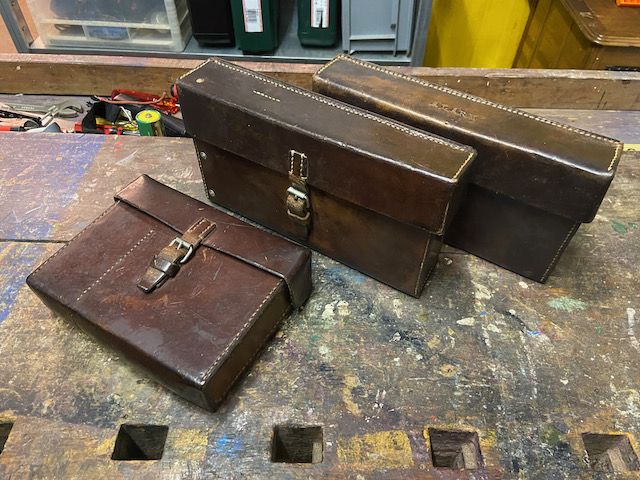
Disassembled VK18.
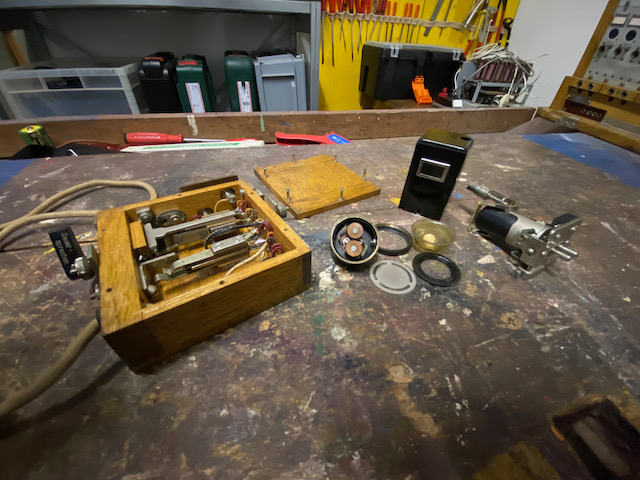
Right side cover removed.
The lid is marked Deckel (Cover) to indicate that this is the side to be opened.
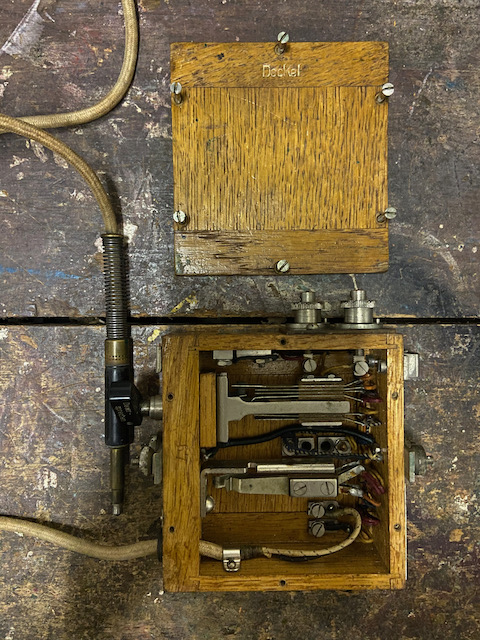
The open relay flap with the yellow flap down.
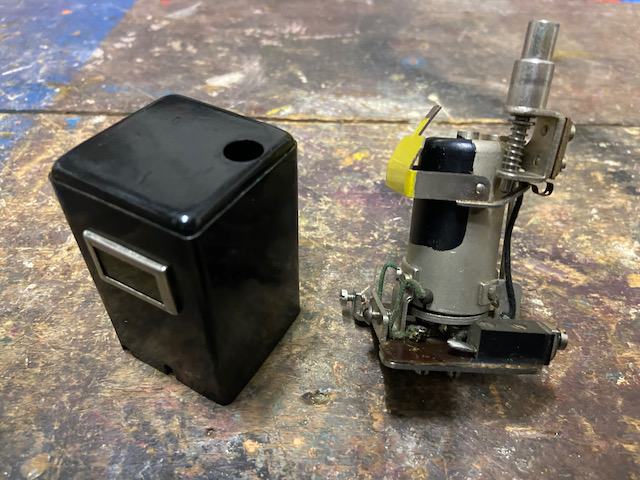
On the cover a Telephonwerke Albisisrieden mark.
The long hook is connected to the relay flap and on the top has a latch which holds and releases the indicator flap.
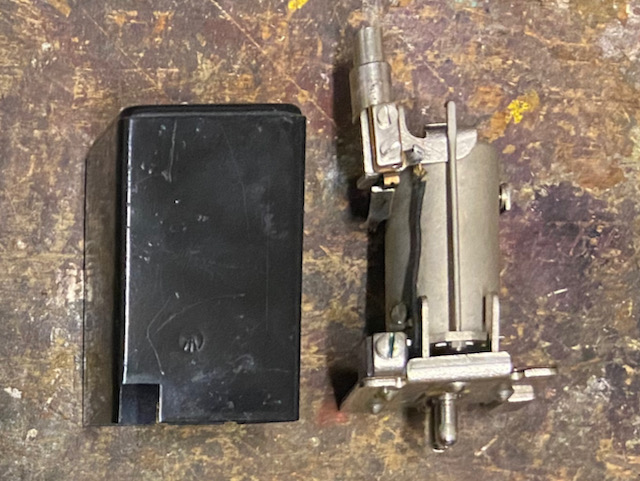
The buzzer indicator is in fact a two pole rx element, the membrane vibrates the elderberry beads and also generates a buzzing tone to indicate an incoming call.
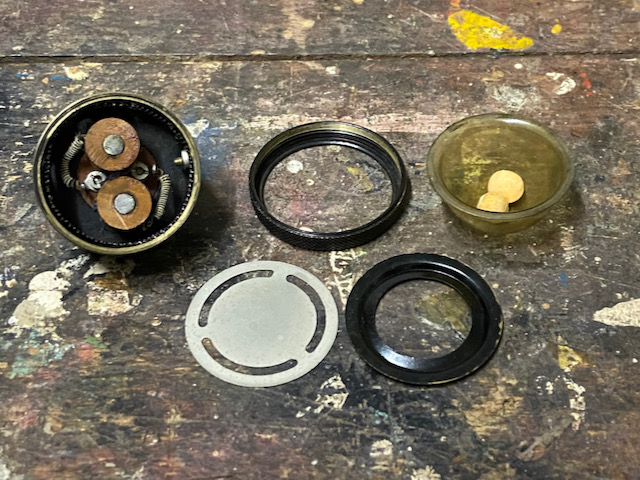
On the left side is a 2 pole socket to connect the operator telephone using a cable with a respective plug.

The operator lever in normal position.
Pushing the lever down connects the operator telephone to Abfragen Rufen Mithören (Query, Call, Listen in).
The lever springs back to normal position when let go.
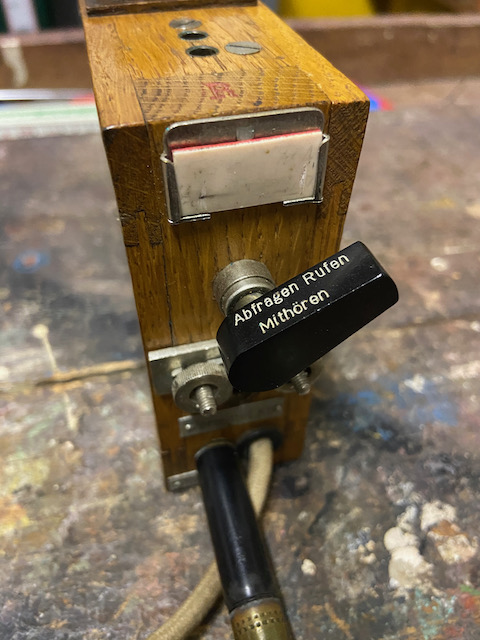
The lever in the fix left position for Dauersprechen (Continous talking).
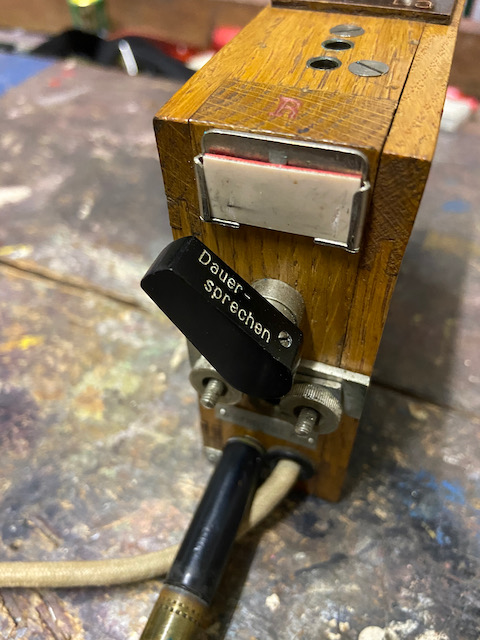
The sockets (Klinke).
The Vermittel Kl. is where to connect the line plug from another VK.
The Ruheklinke is to store the line plug when not in use.

The diagram.
Buchsen f. Anrufzeichen: sockets for the call indicator.
Schalter: switch.
Verbindungslaschen: connection latches.
Abfrageapp.: Operator telephone.

Ready to use with relay flap mounted.

With buzzer indicator mounted.
Behind it the line connectors.
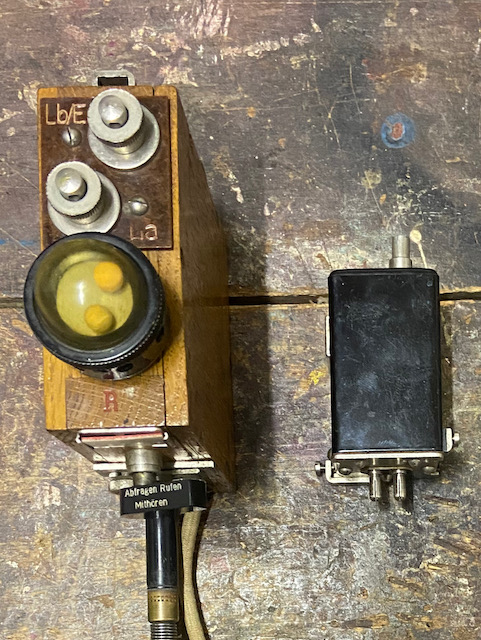
Ready to store.

The relay indicator stored in it's compartment.
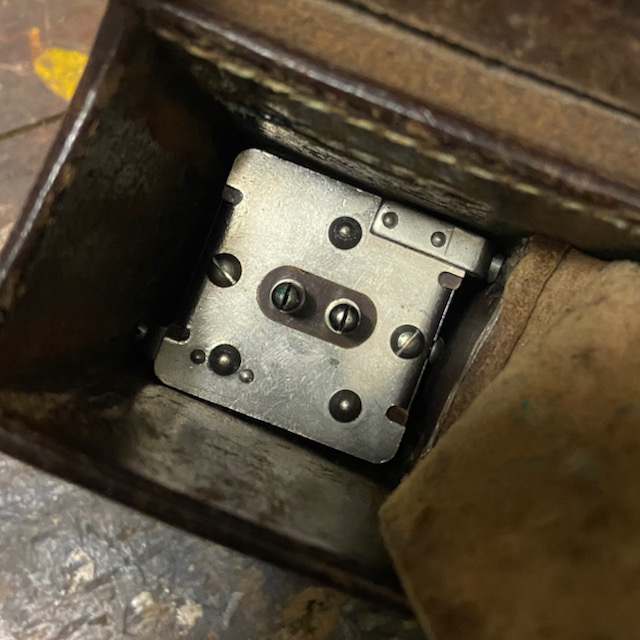
All stored.
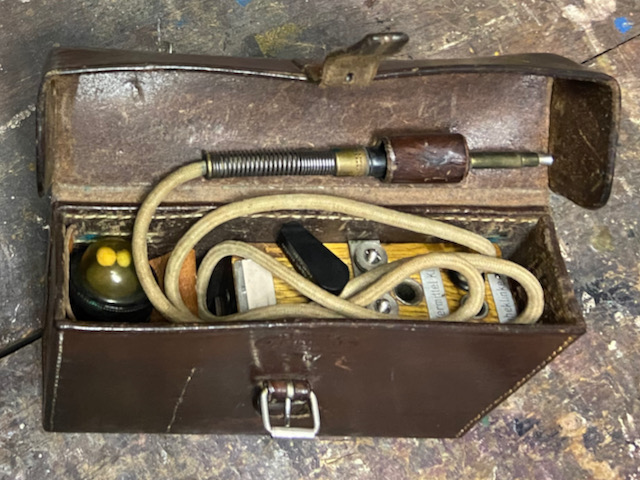
Disassembled VK38.
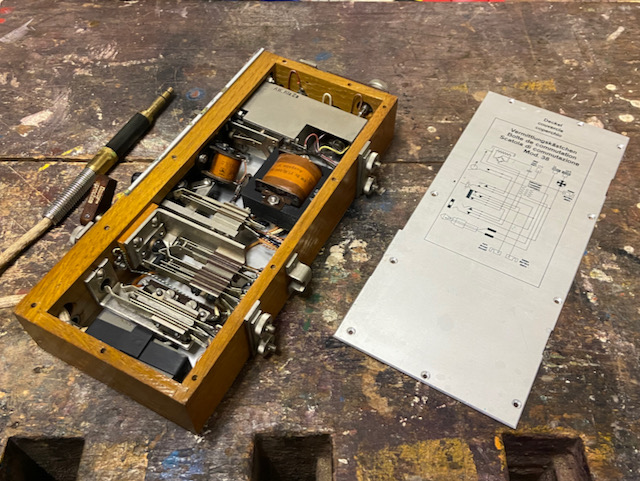
From the left (device bottom) the capacitor,
line socket, operator switch, holding coil switch (with mechanism that locks the operator switch if in off position),
Transformer with date stamp from 1948 (the coil on top of the transformer is the line status indicator),
finally the relay flap module (covered).
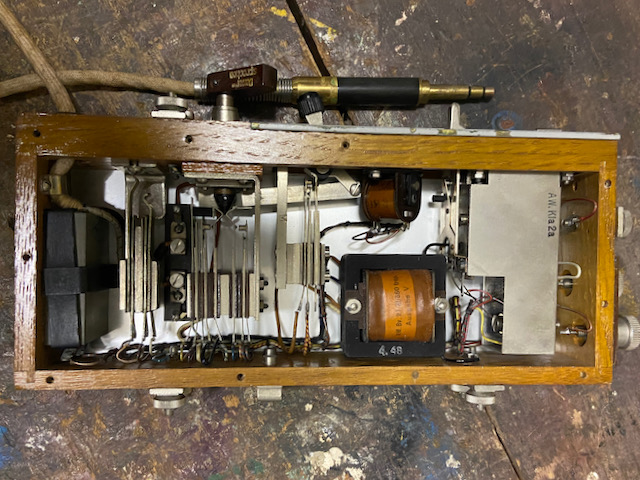
Diagram (German, French and Italian descriptions).
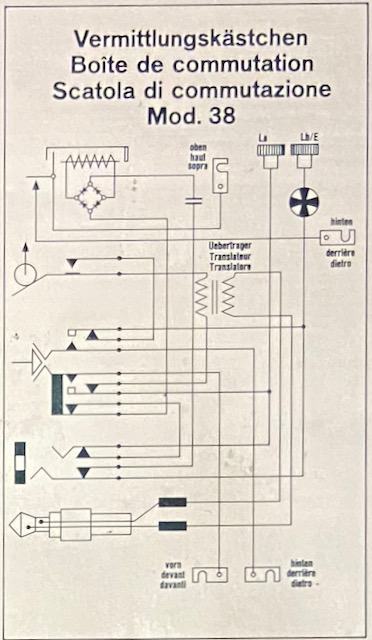
Right side (Removable side, with diagram).
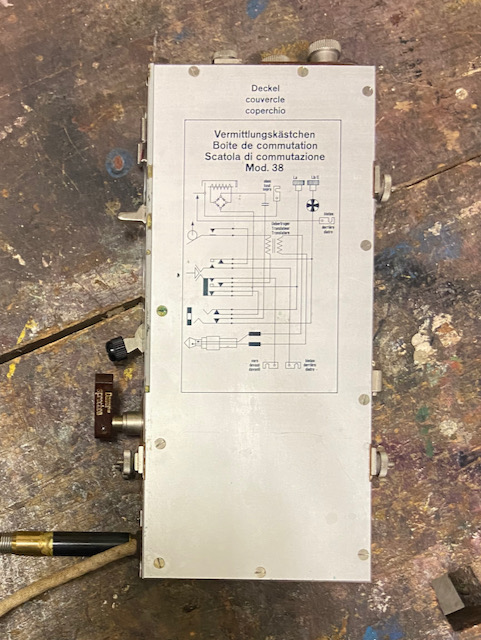
Left side.
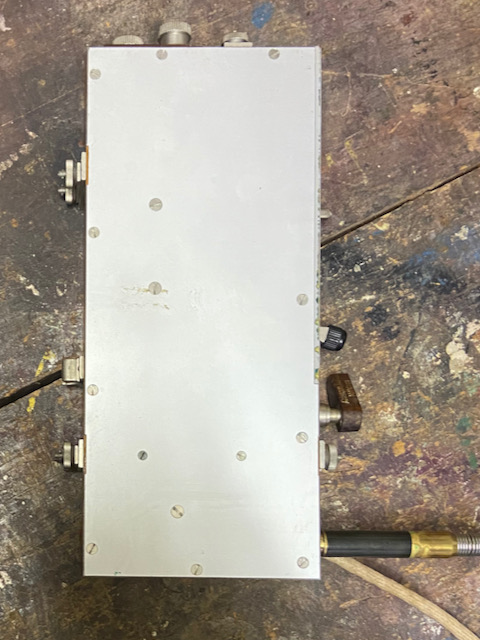
Top.
Line posts.
Top latch (ringer circuit).
Mfg. label: Albiswerk Zürich A.G.

Operator lever in normal position, press to Abfragen Rufen Mithören (Query, Call, Listen in).
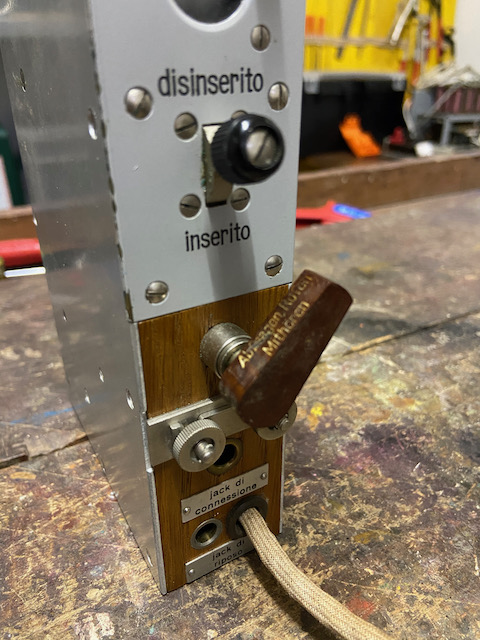
The lever in the fix left position for Dauersprechen (Continous talking).
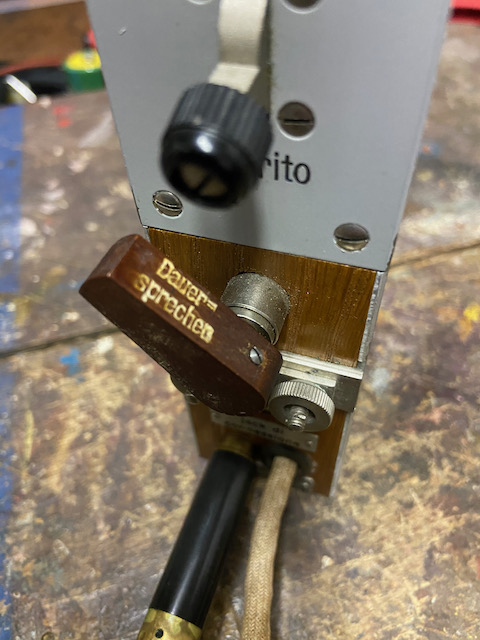
Bottom up: Socket for line plug storage,
line socket,
front operator phone latch,
operator lever,
line activation switch,
line status indicator,
relay flap reset lever,
relay flap indicator,
label to mark line indicaton.

The front labels are in either of the languages German, French or Italian.
On the left unit all is Italian, on the right unit the bottom labels are French and the top German.
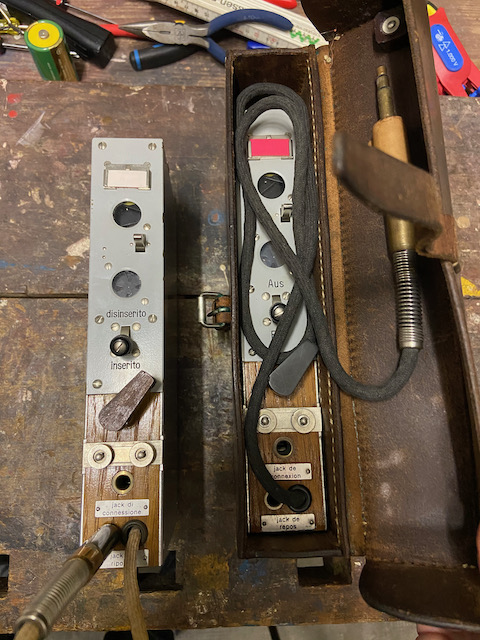
Disassembled.
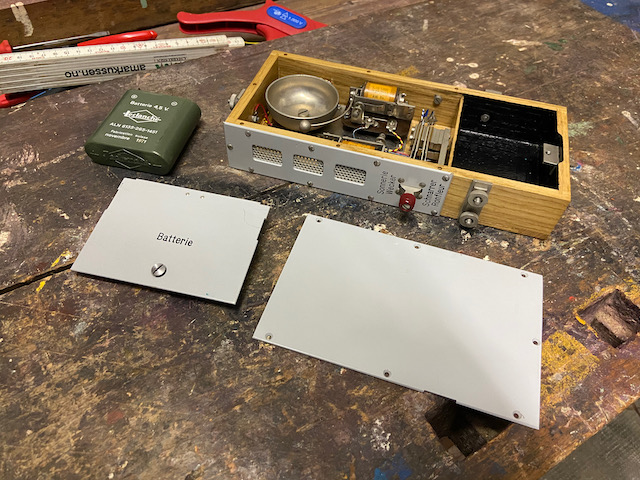
Ringer, buzzer, switch to chose one of the two.
Battery compartment (for a 4,5V flashlight battery).
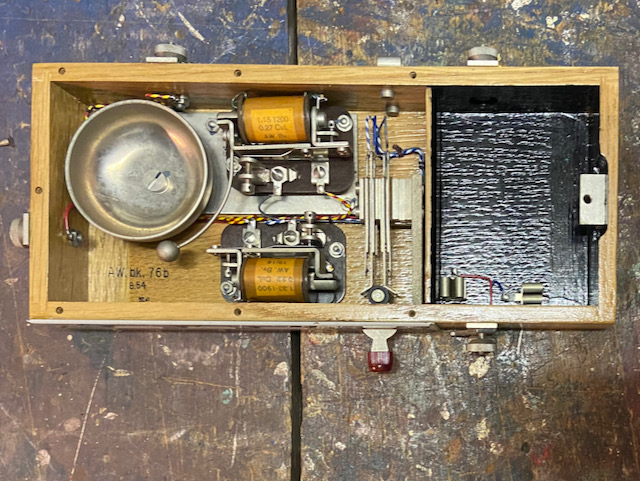
The front is covered by a perforated metal sheet to let the ringing/buzzing sound out.
The lower latches on the Alarmkästchen have no functionality other than fixing it to the Vermittlungskästchen.
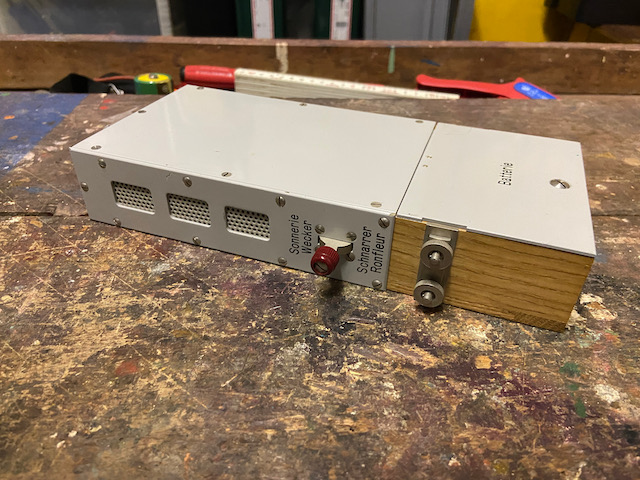
The top latch is part of the ringer circuit, the other end is the upper latch on the back.
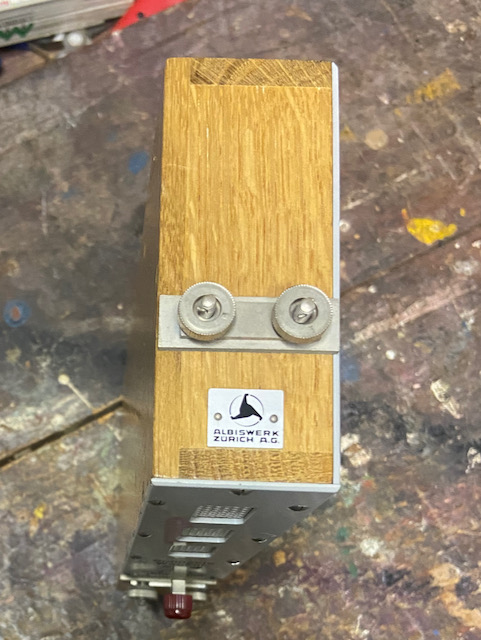
The leather case is marked with Alarm to differentiate it from the Vermittlungskästchen leather cases.
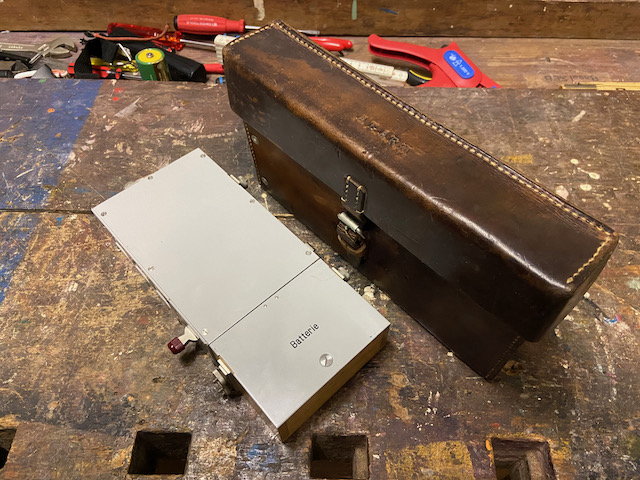
Stored.

Creative Commons Attribution-ShareAlike 4.0 International License